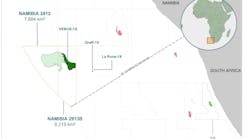Over the last several months, the offshore industry has taken delivery of quite a few drilling units rated for 12,000-ft (3,659-m) water depth. Since to date the deepest water well measured in at 10,411 ft (3,174 m), the world's ultra-deepwater drilling contractors must have visions of still deeper frontiers. And judging by the number of units boasting 12,000-ft capability, the contractors must envisage quite adeepwater boom approaching.
For floating drilling units, deepwater capacity is mainly limited by variable deck load. This is the sum of the weights of all movable equipment on deck from tubulars, to BOP stacks, todrilling and completion fluids. Another limiting consideration is hoisting power, but this more a function of total well depth than water depth.
But for oil and gas well drilling, operators have concerns other than water depth. To ensure that wells actually reach their intended targets requires formation evaluation, and therein lies a challenge.
Click to Enlarge
The deeper the water, the higher the overall drilling and completion risk. Typically, vertical or slightly deviated wells have been evaluated by wireline logging measurements. The service companies have done quite a lot of engineering to make the logging process as safe and efficient as possible. Downhole tools are now combinable so almost all needed services, including fluid samples and formation pressure measurements, can be made in a single trip, saving considerable time and greatly reducing risk. Schlumberger has launched its new TUFFline extra strength logging cable to address the ultra-deep challenge. When bottomhole conditions are considered, wireline logging has a big advantage. The tool string must be able to withstand the heat and pressure at total depth for only a short time.
Operators of high-profile drilling programs value the real-time aspects provided by logging-while-drilling (LWD) tools. Incorporated in the drillstring and close to the bit, LWD tool strings provide quality formation evaluation, including formation fluid and pressure sampling, with data transmitted to surface in real-time. This enables engineers to "geosteer" the wellbore into reservoir "sweet spots" while avoiding geohazards. This greatly reduces drilling risk, so much so that many opt for LWD despite its cost premium.
However, since the LWD instruments must remain at total depth for the entire bit run, they may be exposed to harsh environment conditions of pressure and temperature for quite a long time. They are also subject to severe shock and vibration from the drill bit. Rotary steerable systems (RSS) are the preferred method of geosteering the wellbore because they can make trajectory adjustments faster, and because they eliminate the sliding mode that can hamper drilling performance when mud motors and bent subs are used to direct the drilling. Unfortunately today's RSS typically have temperature ratings below 350°F (175°C).
No matter which formation evaluation type is used, concluding ultra-deepwater drilling operations safely ushers-in a new series of environmental concerns—completions. To improve well performance and avoid production risks, operators are investing in sophisticated completions. Besides the obvious desire to maximize production, they must consider flow assurance, sand management, and corrosion. Other concerns focus on cementing and perforating. To cost-effectively mitigate these issues, or perform these services, requires accurate measurements of downhole conditions. Later, during production, operators need the ability to make downhole flow adjustments. Downhole pressure and temperature gauges, which are at the heart of most production measurements, also have environmental limits. The current temperature record-holder for a downhole pressure gauge is 15 days at 410°F (210°C). Unfortunately, the gauge recorded this temperature several hundred meters above total depth, forcing the operator to make correlations to estimate actual reservoir temperature at the completion.
In addition to instrumentation, sealing technology must keep pace with the drillers. Standard elastomeric seals are stressed by elevated temperatures and pressures. Metal-to-metal seals can deform under pressure; then fail when the pressure is relieved.
For the past few years, good news has been coming ashore from many ultra deepwater projects. Many, if not most, discoveries boast of massive reservoirs, hundreds of feet thick and containing millions of barrels of high-quality crude oil. The prize more than justifies the investment.
But if the industry is going to be successful in drilling, completing, and producing ultra-deep wells in ultra-deepwater, greater strides must be made to develop reliable downhole instrumentation that can withstand bottomhole conditions for the life of the reservoir. What good are drillships that can drill in 12,000 ft of water and 40,000 ft (12,192 m) of rock if logging and production tools cannot perform under those conditions?





